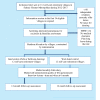Can social dancing prevent falls in older adults? a protocol of the Dance, Aging, Cognition, Economics (DAnCE) fall prevention randomised controlled trial
- PMID: 23675705
- PMCID: PMC3691670
- DOI: 10.1186/1471-2458-13-477
Can social dancing prevent falls in older adults? a protocol of the Dance, Aging, Cognition, Economics (DAnCE) fall prevention randomised controlled trial
Abstract
Background: Falls are one of the most common health problems among older people and pose a major economic burden on health care systems. Exercise is an accepted stand-alone fall prevention strategy particularly if it is balance training or regular participation in Tai chi. Dance shares the 'holistic' approach of practices such as Tai chi. It is a complex sensorimotor rhythmic activity integrating multiple physical, cognitive and social elements. Small-scale randomised controlled trials have indicated that diverse dance styles can improve measures of balance and mobility in older people, but none of these studies has examined the effect of dance on falls or cognition. This study aims to determine whether participation in social dancing: i) reduces the number of falls; and ii) improves cognitive functions associated with fall risk in older people.
Methods/design: A single-blind, cluster randomised controlled trial of 12 months duration will be conducted. Approximately 450 participants will be recruited from 24 self-care retirement villages that house at least 60 residents each in Sydney, Australia. Village residents without cognitive impairment and obtain medical clearance will be eligible. After comprehensive baseline measurements including physiological and cognitive tests and self-completed questionnaires, villages will be randomised to intervention sites (ballroom or folk dance) or to a wait-listed control using a computer randomisation method that minimises imbalances between villages based on two baseline fall risk measures. Main outcome measures are falls, prospectively measured, and the Trail Making cognitive function test. Cost-effectiveness and cost-utility analyses will be performed.
Discussion: This study offers a novel approach to balance training for older people. As a community-based approach to fall prevention, dance offers older people an opportunity for greater social engagement, thereby making a major contribution to healthy ageing. Providing diversity in exercise programs targeting seniors recognises the heterogeneity of multicultural populations and may further increase the number of taking part in exercise.
Trial registration: Australian New Zealand Clinical Trials Registry ACTRN12612000889853The trial is now in progress with 12 villages already have been randomised.
Similar articles
-
Social Dancing and Incidence of Falls in Older Adults: A Cluster Randomised Controlled Trial.PLoS Med. 2016 Aug 30;13(8):e1002112. doi: 10.1371/journal.pmed.1002112. eCollection 2016 Aug. PLoS Med. 2016. PMID: 27575534 Free PMC article. Clinical Trial.
-
Effectiveness of Senior Dance on risk factors for falls in older adults (DanSE): a study protocol for a randomised controlled trial.BMJ Open. 2016 Dec 30;6(12):e013995. doi: 10.1136/bmjopen-2016-013995. BMJ Open. 2016. PMID: 28039296 Free PMC article. Clinical Trial.
-
Effect of Senior Dance (DanSE) on Fall Risk Factors in Older Adults: A Randomized Controlled Trial.Phys Ther. 2020 Apr 17;100(4):600-608. doi: 10.1093/ptj/pzz187. Phys Ther. 2020. PMID: 31899491 Clinical Trial.
-
Effectiveness of dance interventions for falls prevention in older adults: systematic review and meta-analysis.Age Ageing. 2024 May 1;53(5):afae104. doi: 10.1093/ageing/afae104. Age Ageing. 2024. PMID: 38776214 Free PMC article.
-
Association of Dance-Based Mind-Motor Activities With Falls and Physical Function Among Healthy Older Adults: A Systematic Review and Meta-analysis.JAMA Netw Open. 2020 Sep 1;3(9):e2017688. doi: 10.1001/jamanetworkopen.2020.17688. JAMA Netw Open. 2020. PMID: 32975570 Free PMC article.
Cited by
-
Social Dancing and Incidence of Falls in Older Adults: A Cluster Randomised Controlled Trial.PLoS Med. 2016 Aug 30;13(8):e1002112. doi: 10.1371/journal.pmed.1002112. eCollection 2016 Aug. PLoS Med. 2016. PMID: 27575534 Free PMC article. Clinical Trial.
-
Coproducing justice in public involvement: impact-led iterative development of a dance based community engagement project building relationships in marginalised communities.Res Involv Engagem. 2025 May 8;11(1):44. doi: 10.1186/s40900-025-00714-2. Res Involv Engagem. 2025. PMID: 40340780 Free PMC article.
-
Effects of a Multifactorial Program with Case Management for Falls Prevention on Functional Outcomes in Community-Dwelling Older People: A Randomized Clinical Study.Healthcare (Basel). 2024 Aug 3;12(15):1541. doi: 10.3390/healthcare12151541. Healthcare (Basel). 2024. PMID: 39120244 Free PMC article.
-
Effects of Yoga-Like Exercises on Mild and Moderate Alzheimer Disease: A Randomized Controlled Trial Protocol.Tunis Med. 2025 Jan 5;103(1):58-64. doi: 10.62438/tunismed.v103i1.5341. Tunis Med. 2025. PMID: 39812195 Free PMC article. English.
-
A usability study of a multicomponent video game-based training for older adults.Eur Rev Aging Phys Act. 2020 Jan 11;17:3. doi: 10.1186/s11556-019-0233-2. eCollection 2020. Eur Rev Aging Phys Act. 2020. PMID: 31938075 Free PMC article.
References
-
- World Health Organization. WHO Global Report on Falls Prevention. Geneva: World Health Organization; 2007. (Ageing and Life Course).
-
- Bradley C, Pointer S. Hospitalisations due to falls by older people, Australia 2005–06. Adelaide: Australian Insititue of Health and Welfare; 2008.
-
- Centre for Health Advancement and Centre for Epidemiology and Research. New South Wales Fall Prevention Baseline Survey: 2009 Report. Sydney: New South Wales Department of Health; 2010.
-
- Cumming RC, Salkeld G, Thomas M, Szonyi G. Prospective study of the impact of fear of falling on activities of daily living, SF-36 scores, and nursing home admission. J Gerontol. 2000;55A(5):299–305. - PubMed
Publication types
MeSH terms
LinkOut - more resources
Full Text Sources
Other Literature Sources
Medical
Research Materials
Miscellaneous


